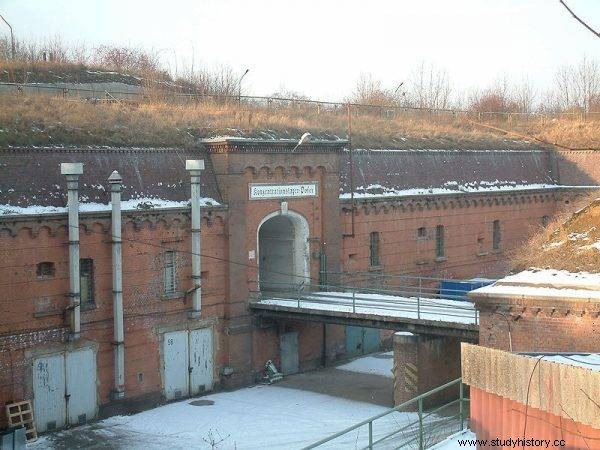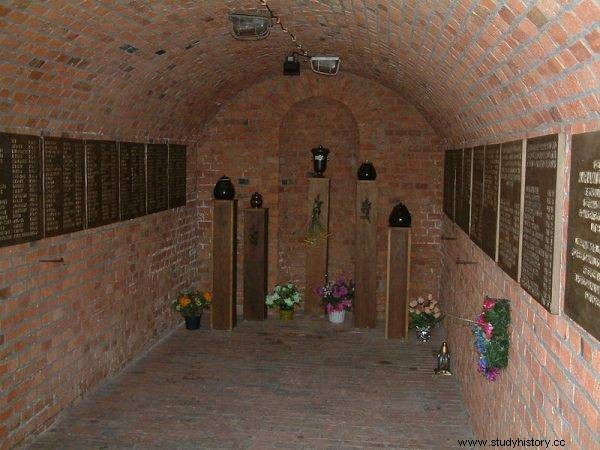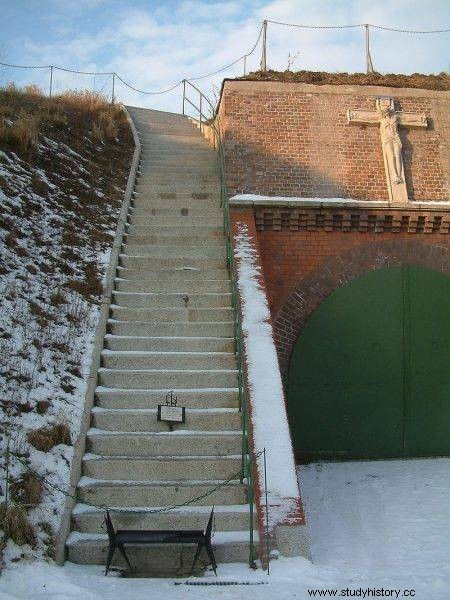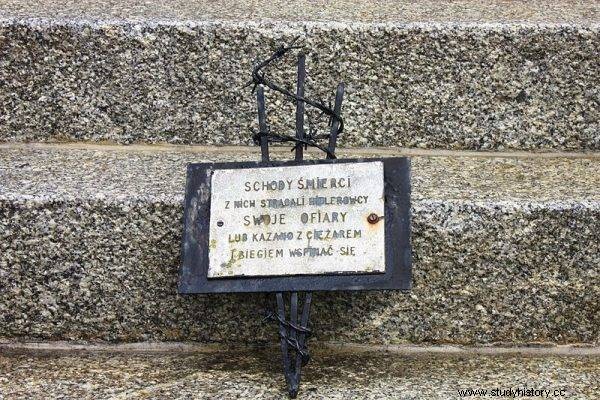Fort VII in Poznań was the first concentration camp in Poland. He had the sinister fame of a death factory. The transfer from here to Auschwitz was good news.
It was one of the first buildings in the Poznań fortress system built by the Prussians in the 19th century. It was built in the years 1876-1880 and was named Fort VII Colomb in honor of Friedrich August Peter von Colomb, general of Prussia, commander of the 5th Army Corps in Poznań. In the interwar period, the fort served as ammunition warehouse for the 3rd Air Regiment . In the defensive war of 1939, it was not used in combat.
Concentration camp at Fort VII
The Germans became interested in the fort very quickly. As soon as on October 10, 1939, they opened a concentration camp there . Konzentrationslager Posen was subordinate to the Einsatzgruppe VI - the security police. In November 1939, it became a temporary Gestapo camp (Geheime Staatspolizei Uebergangslager). This name was in force until mid-1941, when Fort VII was transformed into a security police prison and a labor education camp (Polizeigefängnis der Sicherheitspolizei und Arbeitserzeihungslager).
From the very beginning, the Germans tried to make it have a special character. Prisoners were to be taken from here to other concentration camps or killed on the spot. Or they were supposed to wait for the court decisions. However, it was supposed to be literally a death camp, a camp for the extermination of Wielkopolska. A place where two goals were pursued simultaneously:the most valuable units were liquidated and the rest were intimidated. The point was that the Poles should not resist. This one was supposed to end in one way: entering the fortress gate straight into the hands of executioners with a degenerate psyche.

Today it is estimated that 15,000–20,000 prisoners were murdered in the Fort and in the forests.
In KL Posen, the service - because it can hardly be called work - was performed by people with the most sadistic inclinations finding personal pleasure in murdering and inflicting suffering. Fort was a springboard into a career for SS men in the network of German concentration camps. The crew consisted of 50-80 officers.
It was said bluntly - death camp
The Germans themselves called it Lager der Blutrache, the camp of bloody revenge . Because in fact he was a tool of revenge against those who, several years earlier, had dared to fight back against the invader. Thus, the Wielkopolska and Silesian insurgents from the proscription lists prepared by the Germans before the war were sent to dark, ice-cold cells. They included professors, teachers, doctors, clergy, artists, representatives of the Polish administration. They were often brought in badly beaten after earlier interrogations in the Gestapo torture chamber in the former Soldier's House in Poznań. They were either murdered on the spot or taken to be shot to the Palędzko-Zakrzewskie forests near Poznań, in the vicinity of Rożnowice or Dębienko.
Today it is estimated that 15,000-20,000 prisoners were murdered in the Fort and in the woods. The exact numbers cannot be determined because the perpetrators did not keep scrupulous documentation, and they destroyed the files that existed at the end of the war. Among the victims was, among others Mikołaj Kiedacz, Mayor of Poznań. The Germans also killed the painter Leon Prauziński, the commander of the Poznań Gray Ranks, Jan Skrzypczak, the delegate of the Polish Government in London, Jan Wojkiewicz, and Franciszek Witaszek, a doctor, head of the Poznań District Retaliation Union.

Bunker No. 16 in the artillery rampart, used during World War II by the Germans as a gas chamber in Fort VII
Placing him in Fort VII was almost tantamount to a death sentence. It became so absurd (from today's perspective) that the prisoners of KL Posen were happy to hear that they would be transported to another camp - Auschwitz or Gross Rosen. They treated it as a hope of survival. They preferred to be anywhere but here. Yes, they didn't expect anything good from the other concentration camps, but they believed that nothing could be more terrible than Fort VII.
A trip to the Carpathians and the bell
No wonder, since the perpetrators enjoyed cruel "games", most often ending in the death of the tortured victims. One of the favorite forms of "entertainment" of the Nazi degenerates was a "trip to the Carpathians". What was it about? In winter, water was poured over a steep, several-meter-long slope inside the fort, and when it froze, prisoners were chased on it. Slipping and bumping into each other, constantly being beaten and kicked, they climbed the mountain. When they got there, the SS men threw them head down. Then they were to climb the mountain again.
When there was no frost, the inmates were driven up narrow, steep stairs, ordered to carry heavy stones. Amused torturers stood at the top of the stairs, kicking the unfortunates as they entered, aiming for their heads. As they fell down, dragging others with them, they fell into the hands of the executioners below. Those prisoners who still had strength were forced to enter again. The torment usually lasted as long as they did not die during the climbing and falls or were cruelly killed . It was rare for exhausted prisoners to be allowed back to their cells. Most often, the SS "finished their work", disappointed that this was the end of their "fun", because the tortured prisoners no longer had the strength or were dying.
Another cruel "entertainment" of the camp staff was the "bell" . The victim was hanged by the legs in the camp's bathhouse, upside down, hands tied behind the back . The detainee was then pushed to swing more and more until he finally hit his head against the sinks. After such a torment, other prisoners were called to clean up traces of blood, bone and brain from the walls and floor.
Bestial torture
The SS men also had "hare games" for themselves. They consisted in organizing a race of prisoners who were supposed to jump like hares, while the torturers shot them as if they were hunting . In turn, during the "dog game", the prisoners were to run on all fours and bark, and the SS men beat them with whips.

The stairs of death in Fort VII
In addition to sophisticated torture, the prisoners suffered day and night. The cells were plunged into darkness, and the lights were only turned on when SS-men ran in, dragging more victims outside. The temperature was only 8-10 degrees and high humidity. At the same time, it was very stuffy. Prisoners led out of the thick fortress walls to the light of day often lost their eyesight which was tantamount to a death sentence.
Diseases such as typhus, tuberculosis and dysentery were spreading in the camp. The prisoners were completely deprived of medical assistance. Many of the badly beaten died in cells, into which the perpetrators often fell, beating their helpless victims blindly with rifle butts.
The first gas chambers
Few people know that gas chambers were tested in Fort VII . In the former artillery station, as early as October 1939, it was investigated how to poison people en masse with carbon dioxide transported in huge cylinders. At this stage - because the technology was later improved - the Germans decided that the gas chambers were ineffective . It took about 30-40 minutes to open the chamber after gassing and remove the body. Later, the bodies had to be loaded onto trucks and transported away. Therefore, after two months, this method of killing was abandoned. Instead, movable gas chambers were introduced. These were specially sealed trucks , into which it was not necessary to load the bodies of murdered prisoners. It was just that the living were brought in and the dead were taken away.
The Germans called the gassing of prisoners the elimination of a life not worth living . They applied these words especially to the first victims of the gas chambers:the mentally ill - patients of the psychiatric hospital in Owińska and the psychiatric-neurological clinic of the University of Poznań.

One of the favorite forms of "entertainment" of Nazi degenerates was "a trip to the Carpathians."
They also made sure that the awareness of the extermination camp paralyzed the inhabitants of Wielkopolska . Thus, among the prisoners brought in, there were the so-called Sunday, driven to Fort VII on Saturday and Sunday. They were Poles who did not work diligently enough for the occupying forces. They were forced to listen to the screams of the SS and the groans of the murdered prisoners. They were filled with fear in crowded, smelly cells so that when released they would not think of any resistance to German rule. It was the best possible method of mentally breaking Poles, whom - so far - there was no need to kill.
Museum in the former camp
The concentration camp in Fort VII operated until 1944. His role was gradually taken over by the Żabików camp from 1943. At the end of the war, the assembly lines of the Telefunken Gesellschaft für drahtlose Telegraphie m.b.H. factory were installed in the fort.
After the war, the fort's premises became military warehouses. They were inaccessible to visitors until 1979. Then the Museum of Greater Poland Martyrdom was opened in part of the fort . Finally, in 2000, the city took over the entire facility, giving Fort VIII to the military in return. Today, the Museum invites visitors. It is important to remember that the history lessons here are different from simply visiting the exhibition, if we use the knowledge of a guide. Only then will we look differently at the grassy slopes, the stairs of death, the camp bathhouse or the place near the wall where prisoners were put before being shot ...
Bibliography:
- Aleksandra Pietrowicz, Establishment of a concentration camp in Fort VII in Poznań, October 10, 1939 , ipn.gov.pl (accessed:February 23, 2022).
- Museum of Greater Poland Martyrdom - Fort VII.
- Grzegorz Okoński, Fort VII in Poznań - the first concentration camp in Poland where gas chambers were used for the first time , "Głos Wielkopolski", September 1, 2021.
